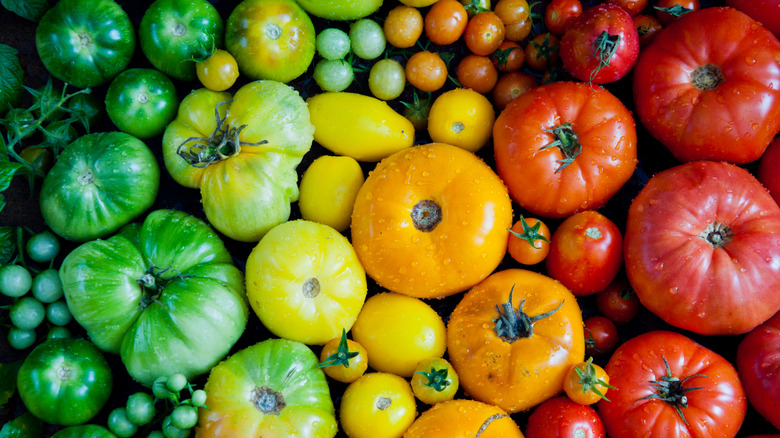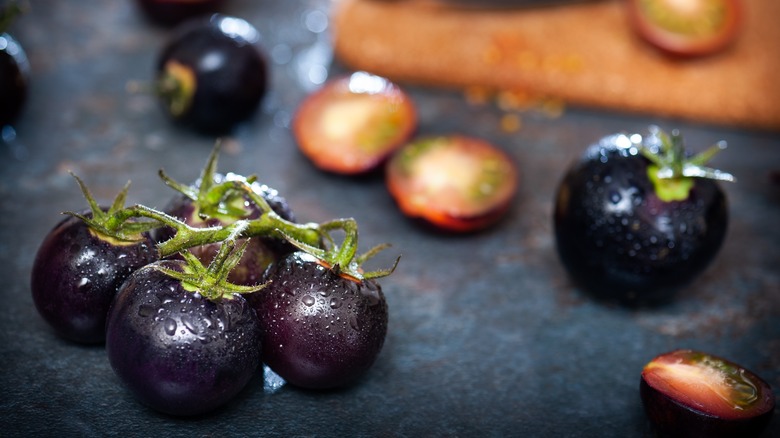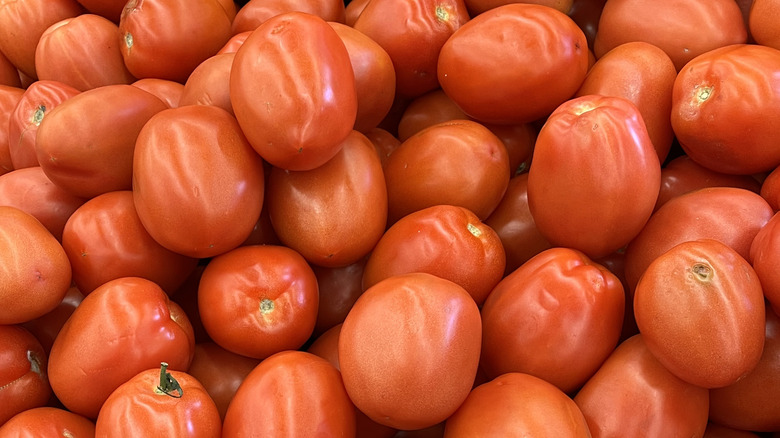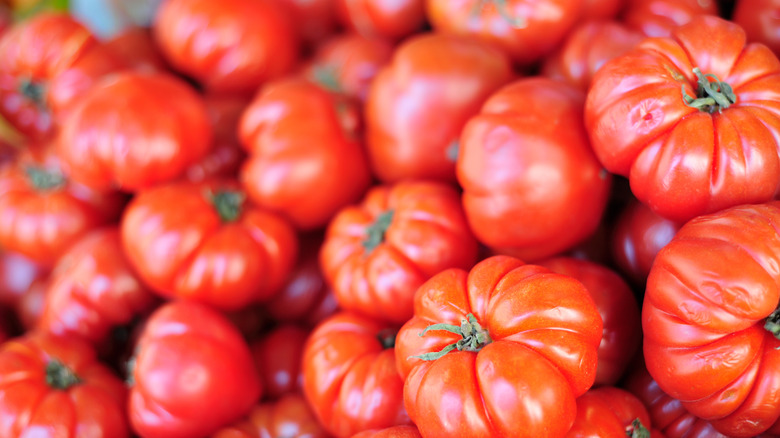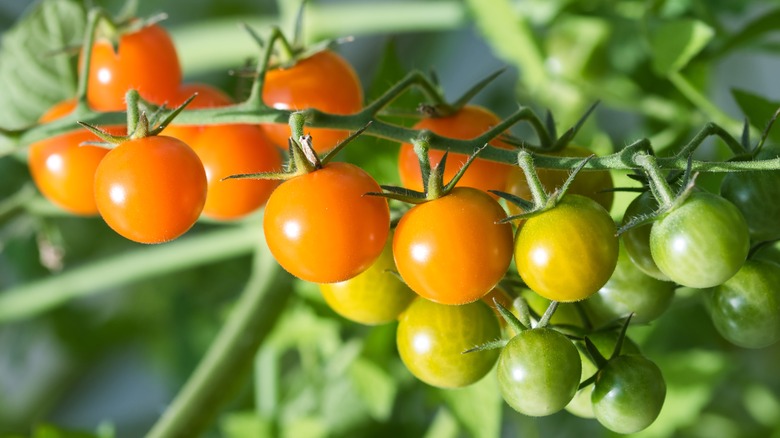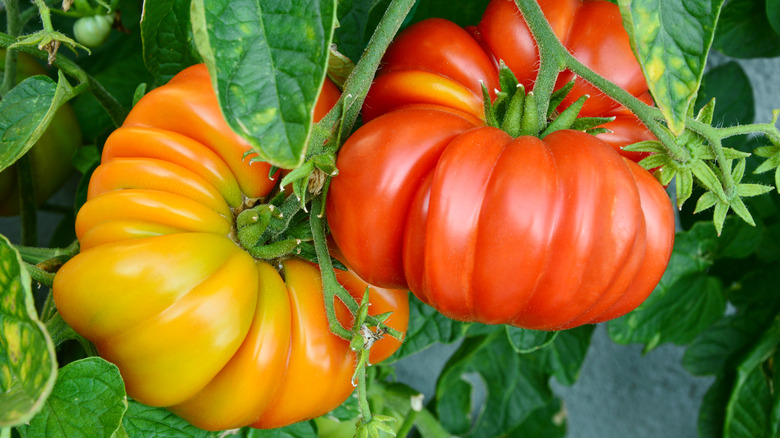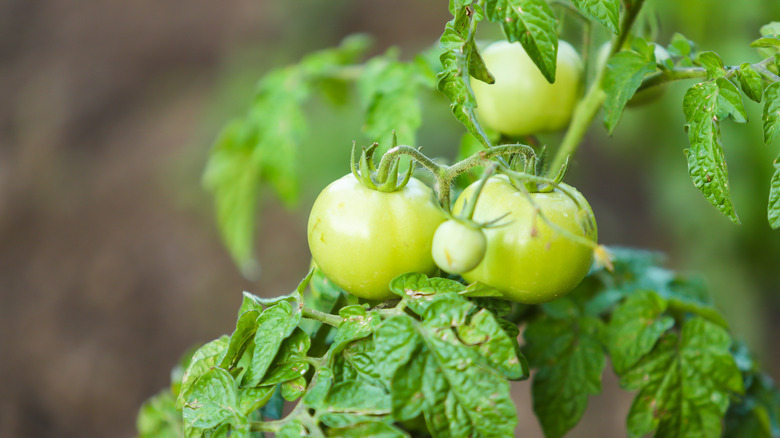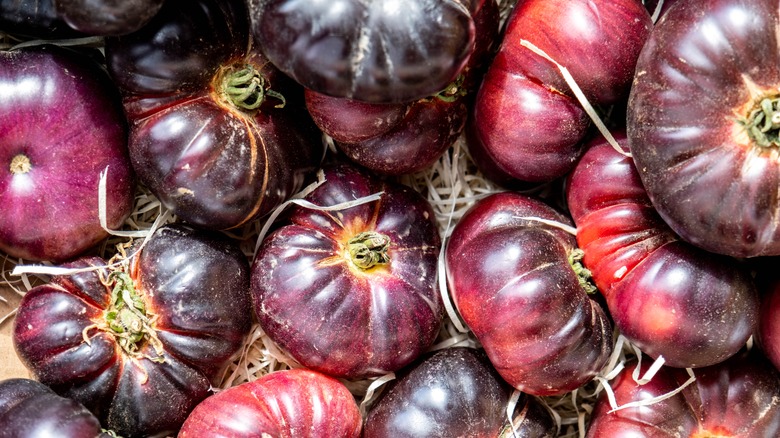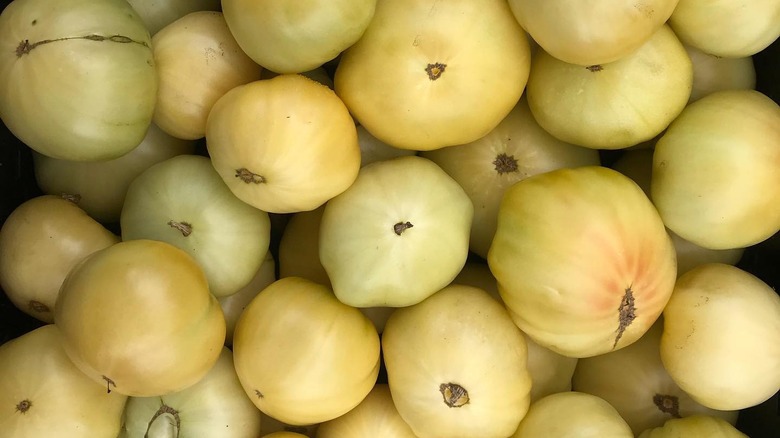5 Types Of Tomatoes To Buy And 3 To Avoid For Maximum Flavor
When shopping for tomatoes, it's easy to grab the same variety over and over again. From classics like beefsteak or grape tomatoes to seasonal favorites like heirlooms, it's easy to get stuck in a rut. And while these tried-and-true options might ensure you know exactly what you're getting, it might be time to expand your horizons beyond the usual tomatoes you see in the produce section of most grocery stores. From flavorful yellow cherry tomatoes to striking purple heirlooms, there is nearly an endless selection of tomatoes that will tempt your taste buds.
Though most tomatoes out there will deliver on texture, flavor, and versatility, there are some varieties that reign supreme — while others fall flat. We've rounded up our favorite tomatoes we think you should buy — and a few that you should avoid — the next time you head to the store or farmers market. Read on to discover our must-have tomato varieties and learn about the pitfalls of our least-favorites to help you make an informed decision the next time you shop.
Buy: Black Cherry tomatoes
Black Cherry tomatoes are a cherry tomato variety that gets its name from its distinct dark reddish purple hue. This beautiful fruit is an incredibly sought-after tomato — especially among gardeners and tomato aficionados — thanks to its sweet and intense flavor. Though ultra sweet like regular cherry tomatoes, this darker variety has a richer flavor than red or yellow versions. Similarly to other cherry tomatoes, it also has a very concentrated flavor compared to larger fruit because of the smaller size and lower water content.
The easy-to-grow plant is a perfect option for amateur gardeners, and it tends to yield a lot of fruit for a plentiful supply of Black Cherry tomatoes all summer long. Just proceed with caution after heavy rainfall — these tomatoes in particular tend to split when exposed to too much water. That also means you should tread carefully to avoid unintentionally overwatering them.
Buy: Roma tomatoes
Roma tomatoes are a variety of plum tomatoes easily found in almost any grocery store. And there's a good reason for their popularity; these super-dense tomatoes have very few seeds and aren't as juicy as beefsteak tomatoes or heirloom varieties. While at first these may seem like negative qualities, they are the same traits that make these tomatoes perfect for uses beyond sandwiches and other raw preparations.
Their low levels of acidity and high sugar content mean that Romas are sweeter than other tomatoes. And while they are delicious when eaten fresh, they really shine when cooked down and used in pasta sauce or to make tomato paste (which is why they are also known as paste tomatoes). Their sweetness becomes more concentrated as the water evaporates, resulting in a sweet, rich, and decadent sauce that you can eat right away or preserve to savor during the winter months.
Avoid: Beefsteak tomatoes
When they're at their prime, beefsteak tomatoes can be delicious — juicy, meaty, and with a lot of tomato flavor. Mostly used in raw preparations like sandwiches, salads, or salsa recipes, this tomato is easily identifiable thanks to its large size and flattened shape. During the summer, beefsteaks are so flavorful they can even be eaten alone with just a pinch of salt or a splash of olive oil.
This sturdy tomato, however, is only in season for a small portion of the year. Most beefsteak tomato plants produce fruit in July and August, which is a small window for optimal flavor. When it's out of season, this popular variety is watery, bland, and can have a mealy, off-putting texture. Though beefsteaks are available in the grocery store year-round thanks to international agriculture, we'd recommend avoiding them and opting for other varieties instead during the fall, winter, and spring.
Buy: Sun Gold tomatoes
Sun Gold tomatoes look like cherry tomatoes — they're small and round — but instead of the classic red hue, they are a distinct marigold yellow shade. This hybrid cherry tomato ripens at the end of the summer and is known for its super-sweet taste, fruity flavor, and hint of tartness. This distinct combination has given these tomatoes an almost cult-like following, resulting in them often topping lists of favorite tomato varieties. First introduced to the U.S. from Japan in 1992, these hybrid tomatoes are delicious enough to eat right off the vine. They're equally flavorful when added to pasta sauce, used as pizza toppings, or even roasted and caramelized.
While delicious, these small tomatoes are a bit touchier than heartier varieties. Heavy rainfall makes them susceptible to cracking, and the small tomatoes also split easily when handled too roughly, which makes shipping difficult. As a result, they're often only available at local farmers markets or farm stands (or to home gardeners). While this can make them hard to get a hold of, it also makes them a special treat.
Buy: Brandywine tomato
Though technically also a variety of beefsteak, Brandywine tomatoes have all of the pros of regular beefsteaks with few of the cons. These heirloom tomatoes have a meaty interior with a beautiful balance of sweet and acidic flavors that make them easy to cook with. Their colorful, multi-hued exterior makes them an eye-catching variety, with deep red and burgundy tones and hints of green toward the stem known as "green shoulders." They're also ultra-juicy and have a thin skin, making them perfect for sandwiches or salads — or even for juicing.
While these tomatoes are often a farmers market find, you can also grow them on your own to enjoy the delicious flavor all summer long. Whether planted in garden beds or in pots, they'll flourish when placed in a sunny location with twice-weekly watering. After about 80 days, these large, flavorful tomatoes will be ready to harvest.
Avoid: Unripened green tomatoes
While unripened green tomatoes are sometimes fried or used in raw dishes like salsa, they are generally an option you'll want to stay away from. They often don't taste very pleasant; since the fruit hasn't ripened, they can have a very acidic, almost astringent flavor. They are also very crunchy (sometimes unpleasantly so) and don't have any of the juiciness of flavorful ripe tomatoes. If you choose to eat them anyway, just be sure not to eat too many at once. In very large quantities, the alkaloid compounds that give the fruit its bitter taste can reach toxic levels.
Unripened green tomatoes should not be confused with green tomato varieties that remain green once ripened, like Green Zebra or Cherokee Green tomatoes. These varieties can be used in many of the same ways as their red counterparts once ripe, such as on sandwiches, in sauces, or roasted.
Buy: Cherokee Purple tomatoes
Like Brandywine, Cherokee Purple tomatoes are an heirloom beefsteak variety. And while this tomato may be not as well known, it's a frequent favorite among tomato lovers. This pre-1890, Cherokee Indian tomato is known for its deep maroon, purplish hue — which is also how it got its name. The delicious fruit is sweet with a classic and intense tomato flavor.
Like other heirloom tomatoes, Cherokee Purples are dense and juicy, so they're versatile for many preparations, from eating them raw to canning or dehydrating. The distinct color also produces a beautiful and unexpected tomato sauce for pasta dishes. While they may be delicious, Cherokee Purples can also be a bit difficult to grow on your own — especially for amateur gardeners. The vines tend to produce minimal fruit, and the size and irregular shape can cause them to split. To avoid the headache, consider grabbing these on your next trip to the farmers market or grocery store instead.
Avoid: White tomatoes
While you've probably heard of red, yellow, and even green tomatoes, you might not have heard of white tomatoes. This unusual variety isn't a common option in grocery stores or even in farmers markets. Although the name suggests these tomatoes are white, they actually ripen to a light butter yellow hue. They are lower in acidity than red tomatoes, making them the mildest of all varieties. White tomatoes are known for having a subtle flavor that doesn't make a big impact. Some people even gone as far as to call this variety bland.
While some palates may prefer this minimal, barely-there flavor, this characteristic makes these tomatoes an option that most people prefer to skip. They are, however, packed with antioxidants like phytoene and phytofluene, making them a healthy choice not just for your diet, but also a smart option to help improve your skin and cardiovascular health.
